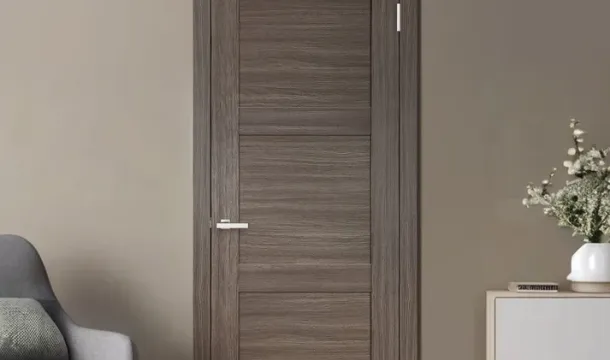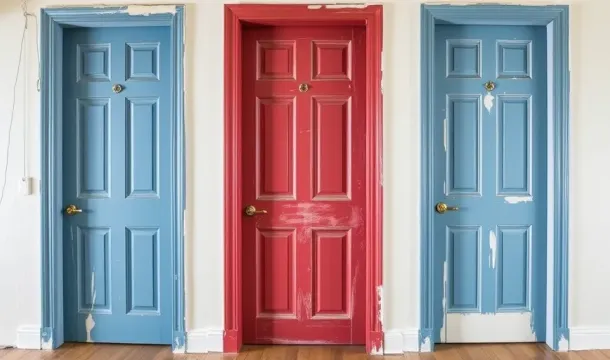How to Soundproof Interior Doors Without Replacing Them
Popular Articles
- Choosing the Perfect Interior Doors for Your Canadian Home
- A Complete Guide to Choosing Interior Doors for Canadian Homes
- The Challenges of Painting Interior Doors
- Understanding Interior Doors and Their Role in Your Home
- The Perfect Blend of Reliability and Design: Interior Doors with Italian "Sandwich" Technology
For an immediate solution to minimize sound disturbance, consider adding mass-loaded vinyl (MLV) to the surfaces of your entryways. This material is specifically designed for noise reduction and can significantly enhance insulation against unwanted sounds. Simply cut MLV to fit and adhere it directly to the door, ensuring a snug fit that blocks external noise effectively.
Another option is to apply weather stripping around the edges of your frames. This simple fix creates a tighter seal, preventing sound from seeping through gaps. Choose high-density foam or rubber strips for optimal results; they not only reduce noise but also improve energy efficiency by sealing air leaks.
To further enhance quietness, consider using acoustic panels or decorative fabric over existing surfaces. These materials absorb sound waves, which reduces echo and helps create a more serene environment. Hang them as wall art or attach them directly to the door for a visually appealing yet functional upgrade.
Assess Existing Door Insulation
To enhance quietness within your home, start by evaluating the insulation of your current doors. Check for gaps and cracks around the edges where sound may leak through. A simple way to assess this is by using a flashlight; shine it along the perimeter of the door while someone else stands on the opposite side. If light passes through, noise can too.
Next, consider the material composition of your doors. Solid-core variants typically offer superior noise reduction compared to hollow-core options. If replacing them isn't feasible, adding mass to hollow doors can be an effective solution. Mounting MDF panels or applying additional layers of soundproofing material will significantly dampen noise transmission.
Don’t overlook weatherstripping as a critical aspect of door insulation. Ensuring that all gaps are sealed with high-quality weatherstripping material can reduce unwanted sound infiltration. Pay special attention to the bottom of the door; installing a door sweep or threshold will further aid in minimizing noise from adjacent rooms.
Lastly, consider utilizing acoustic panels or heavy drapes near your doors. These additions not only serve aesthetic purposes but also contribute to overall sound reduction in your living spaces.
Add Weatherstripping Solutions
Install weatherstripping to enhance noise reduction effectively. This affordable solution helps to seal gaps around the edges, preventing sound from leaking through. Choose materials like foam tape or rubber seals for optimal performance.
- Foam Tape: Easy to apply, this option compresses well and fills small cracks. Ideal for interior applications where minor sound leakage occurs.
- Vinyl Weatherstripping: Durable and resistant to wear, vinyl offers excellent insulation properties. It’s suitable for high-traffic areas.
- Door Sweeps: Attach a sweep at the bottom of the door to block noise traveling underneath. This is particularly effective in rooms with significant foot traffic.
Ensure surfaces are clean before installation for better adhesion. Measure carefully to avoid excess material, which can create gaps that allow noise in. Regularly check weatherstripping for wear and replace as necessary to maintain quiet spaces within your home.
Install Soundproofing Panels
To enhance noise reduction in your home, consider installing acoustic panels. These specialized panels are designed to absorb sound waves, effectively minimizing echoes and reducing overall noise levels. Choose high-density materials such as foam or mass-loaded vinyl for optimal results.
Measure the dimensions of your doors to determine how many panels you'll need. Cut the panels to fit snugly against the surface. Adhesive or mounting hardware can be used for installation, ensuring a secure attachment that won’t compromise aesthetics.
Position the panels strategically; focusing on areas where sound transmission is highest, such as around doorknobs and edges. This targeted approach will create a quieter environment in adjacent rooms.
For additional insulation, consider layering multiple panels or combining them with other solutions like weatherstripping. This multi-faceted strategy will significantly enhance noise abatement and provide a more tranquil living space.
Use Mass Loaded Vinyl
For an effective remedy to minimize sound transmission through existing barriers, consider applying mass loaded vinyl (MLV). This dense material is specifically designed for noise reduction and can be a practical addition to your home.
To implement this solution:
- Measure the dimensions of the barrier you wish to treat.
- Purchase MLV sheets that are thick enough to provide substantial insulation against unwanted sound.
- Cut the MLV to fit the specific sizes needed.
- Affix the MLV directly onto the surface of the barrier using an appropriate adhesive or double-sided tape. Ensure there are no gaps for maximum effectiveness.
The weight of MLV contributes significantly to reducing noise levels, making it an ideal choice for spaces requiring enhanced tranquility. Additionally, it can be painted or covered with fabric for aesthetic purposes while maintaining its soundproofing capabilities.
This strategy not only addresses current noise issues but also enhances overall comfort within your living environment. Consider integrating mass loaded vinyl into your home improvement projects for a quieter space.
Seal Gaps and Cracks
Addressing gaps and cracks around the edges of your entryways is crucial for noise reduction. Begin by inspecting all seams, especially where the frame meets the wall. Use a high-quality caulking compound to fill any noticeable openings. This simple fix can significantly enhance insulation.
For larger gaps, consider using foam sealant or backer rods before applying caulk. These materials expand to fill voids, providing a more effective barrier against sound penetration. Ensure the surface is clean and dry before application for optimal adhesion.
Don’t overlook the space beneath the structure; use door sweeps or threshold seals to minimize sound leakage. These solutions are designed to block noise from entering through lower gaps, contributing to a quieter atmosphere.
Regularly check these areas for wear over time, as maintenance can prevent new issues from arising. A well-sealed environment not only enhances comfort but also improves overall energy efficiency.
Popular Articles
- Choosing the Perfect Interior Doors for Your Canadian Home
- A Complete Guide to Choosing Interior Doors for Canadian Homes
- The Challenges of Painting Interior Doors
- Understanding Interior Doors and Their Role in Your Home
- The Perfect Blend of Reliability and Design: Interior Doors with Italian "Sandwich" Technology

Choosing the Perfect Interior Doors for Your Canadian Home

A Complete Guide to Choosing Interior Doors for Canadian Homes
